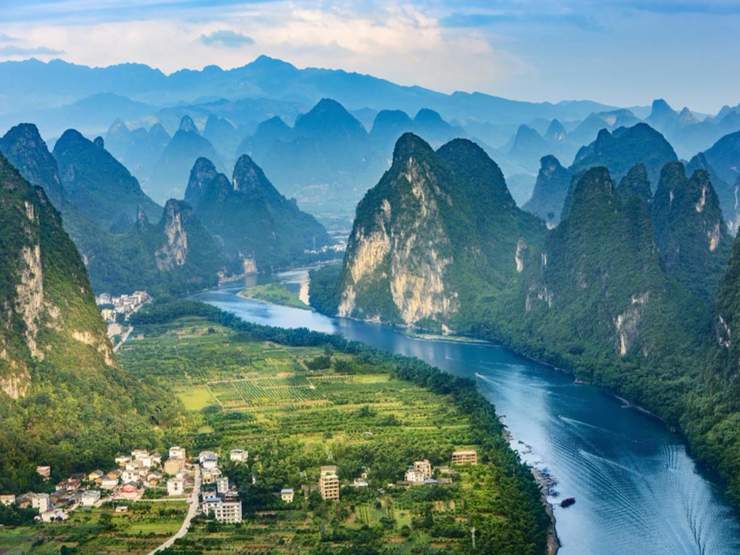Xian attractions and regional tours? Bell & Drum Towers In Chinese history from Ming Dynasty, each city had a bell tower and a drum tower. The bell was sounded at dawn and the drum at dusk each day in ancient time, a means of telling time and coming alerts. Xian was not exception. The Bell Tower and Drum Tower of Xi’an date back to the Ming dynasty (1368-1644). The two are located in the center of the Xian city connecting the four roads from east, south, west and north within the city wall. Atop the Bell Tower you will have a panoramic view of the Xian City; atop the Drum Tower you will have a bird’s eye view of the Muslim Quarters.
Man Mo Temple is a mid-nineteenth-century, Grade I-listed historical building and declared national monument on Hollywood Road. It’s surrounded by antique stores that are common in the area. The temple is mostly dedicated to Man Cheong, the god of literature, and Mo Tai, the god of war, a pair of deities often worshipped by students about to take Imperial China’s civil service exams. With its clouds of intense and introspective calm, it makes for a haven from all the downtown hubbub outside.
China is a fascinating place if you are looking for adventure and ancient history feeling. “Nobody can be a true hero unless he has been on the Great Wall” goes the popular Chinese saying, one that clearly demonstrates the importance placed upon this unique ancient monument. The magnificent Great Wall of China (known in Chinese as “Changcheng,” or the “Long Wall”) stretches more than 6,000 kilometers from the fortresses of Shanhaiguan in the east all the way to Jiayuguan in the west, passing through Hebei, Tientsin, Beijing — where the best preserved sections of the wall can be visited —Inner Mongolia, Ningxia, and Gansu. Averaging six to eight meters in height but rising as high as 16 meters — and wide enough in places for five horses or 10 men to pass — the wall boasts numerous battlements and watchtowers, some dating back as far as the 7th century BC, with the best-known areas added around 210 BC when its various sections were joined. Today, the most visited section of the wall is near Badaling Pass northwest of Beijing, easily reached by public transport or organized tours. Other restored sections worth a visit include the section near Gubeikou, 130 kilometers from Beijing, and in Mutianyu, just 70 kilometers northeast of Beijing. See extra info on Shanghai to Xian tour.
Echoing Sand Mountain is a series of dunes surrounding Crescent Lake. Named for its distinctive shape and aural characteristics, its echoes can be heard as the wind blows over the dunes. Visitors ride camels up the dunes, which rise to 250 meters. With gardens blooming on its banks, Crescent Lake offers a lovely visual counterpoint to all that sand. Echoing Sand Mountain and Crescent Lake is six kilometers south of Dunhuang. China Southern operates a daily return flight between Xi’an Xianyang Airport and Dunhuang Airport. Air China flies between Beijing and Dunhuang once a day.
Originally built by King Songtsen Gampo in the seventh century, the awe-inspiring Potala Palace, perched high above much of Lhasa, is the landmark of the city. Built against the Red Hill, Potala Palace is a spectacular castle-like building complex of Lhasa, which is used to be the unification centre of political and religious of Tibet. Covered an area of over 360,000 square meters, it is a great palace of art with creative designing and gorgeous decoration. Its conservative religious atmosphere, precious scriptures, murals, jewels and antiques housed inside, earning it a place on UNESCO World Cultural Heritage Site list.
Tiger Leaping Gorge is situated on the Yangtze River in southwestern China. About 15 km (9 miles) in length, the canyon passes through a series of rapids surrounded by mountains on both sides that sharply rise 3,000 meters (10,000 feet) above the river. It is believed to be the deepest canyon in the world – depending on the criteria applied. The hiking trail through the gorge is one of the most accessible and satisfying in China, with dramatic scenery. The hike is not to be taken lightly though. Even for those in good physical shape, it’s a workout and can certainly wreck the knees. Accommodation along the way is in guesthouses, so hikers won’t need a tent. Suzhou is a picturesque city located on the Grand Canal about 65 km (40 miles) from Shanghai. It is famous for its silks, the canals that run through the city, and for its classical gardens with their fish ponds and rockeries. Suzhou has about 80 classical gardens; the Humble Administrator’s Garden is among the most famous. A canal boat ride is a good way to experience the exquisiteness of Suzhou. Find extra info on https://www.chinaxiantour.com/.
